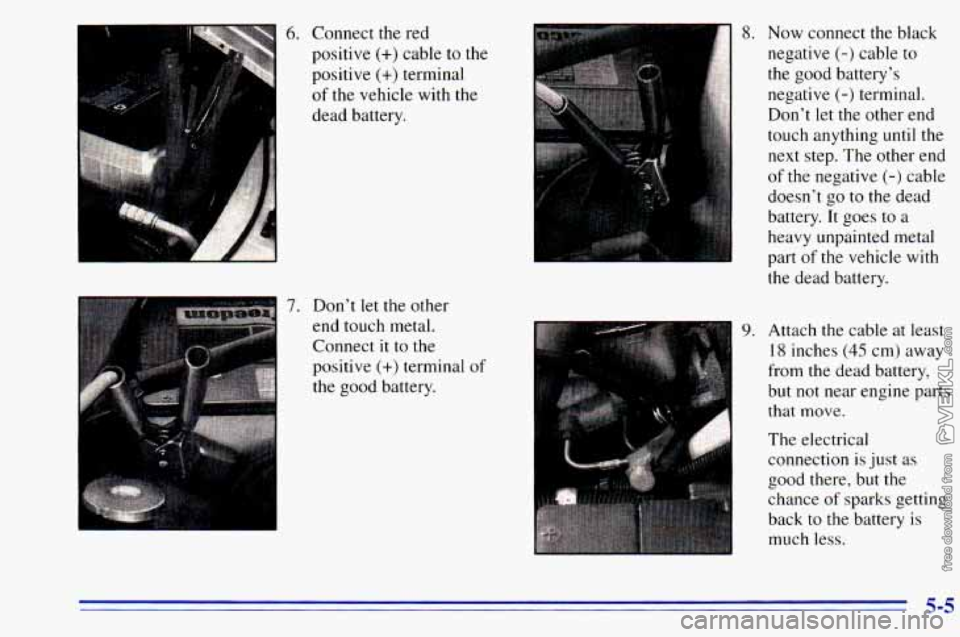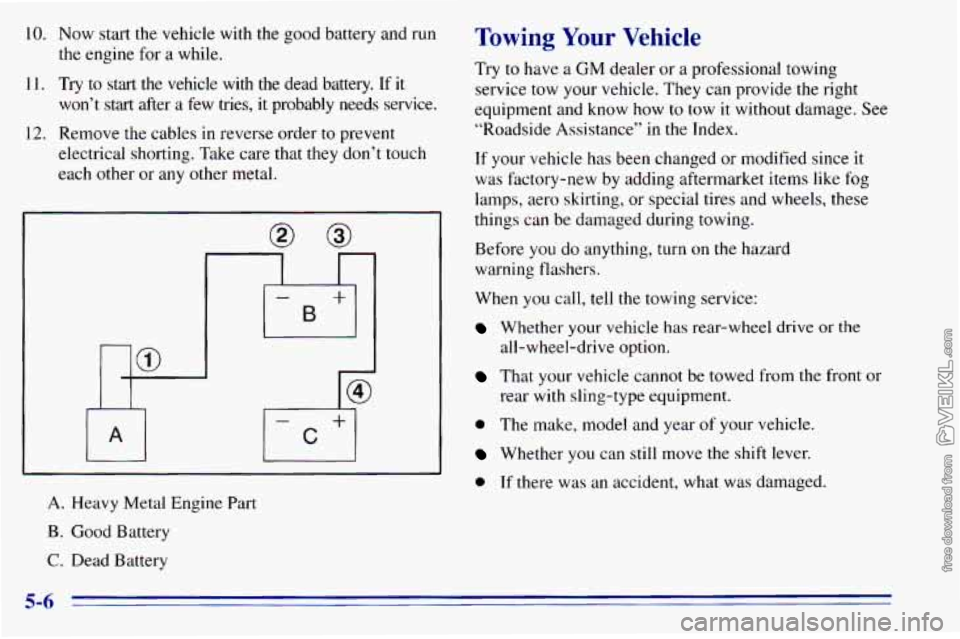1996 CHEVROLET ASTRO dead battery
[x] Cancel search: dead batteryPage 71 of 372

Hatch
A CAUTION:
It can be dangerous to drive with the rear
swing-out windows, rear hatch or rear doors
open because carbon monoxide (CO) gas can
come into your vehicle. You can’t see or smell
CO. It can cause unconsciousness and even death.
If you must drive with the rear swing-out
windows, rear hatch or rear doors open or
if
electrical wiring or other cable connections must
pass through the seal between the body and the
rear swing-out windows, rear hatch or rear doors:
Make sure all windows are shut.
’hrn the fan on your heating or cooling
system to its highest speed with the setting
on anything but MAX A/C. That will force
outside air into your vehicle. See “Comfort
Controls” in the Index.
instrument panel, open them all the way.
If you have air outlets on or under the
See “Engine Exhaust” in the Index.
Rear Hatch and Dutch Doors Release
(Option)
If you have this option, your vehicle must be in either
PARK (P) or NEUTRAL
(N) to release the hatch and
unlock the Dutch doors. If your battery
is dead, the
hatch and Dutch doors will not open,
even from the
outside with a key.
To release the hatch and
unlock the doors from the
inside of the vehicle, press
the REAR HATCH button
on the instrument panel.
It
is located on the right side of the steering column. The
hatch will release with or without the key
in the ignition.
Then, pull up on
the hatch handle and open the doors.
2-11
Page 179 of 372

Snow can trap exhaust gases under your vehicle.
This can cause deadly
CO (carbon monoxide) gas
to get inside. CO could overcome you and kill
you. You can’t see it or smell it,
so you might not
know it is in your vehicle. Clear away
snow from
around the base of your vehicle, especially any
that is blocking your exhaust pipe. And check
around again from time to time to be sure snow
doesn’t collect there.
Open a window just a little on the side of the
vehicle that’s away from the wind. This will help
keep CO out. Run your
engine only as long as you must. This saves
fuel. When you run the engine, make it go a little faster
than just idle. That
is, push the accelerator slightly. This
uses less fuel for the heat that
you get and it keeps the
battery charged. You will need a well-charged battery
to
restart the vehicle, and possibly for signaling later on
with your headlamps. Let the heater run for awhile.
Then, shut the engine off and close the window almost
all the way to preserve the heat. Start the engine again
and repeat
this only when you feel really uncomfortable
from the cold. But do it as little as possible. Preserve the
fuel as long as you can. To help keep warm, you can get
out of the vehicle and do some fairly vigorous exercises
every half hour
or so until help comes.
4-25
Page 197 of 372

6. Connect the red
positive
(+) cable to the
positive
(+) terminal
of the vehicle with the
dead battery.
7. Don’t let the other
end touch metal.
I
Connect it to the
positive
(+) terminal of
the good battery.
8. Now connect the black
negative
(-) cable to
the good battery’s
negative
(-) terminal.
Don’t
let the other end
touch anything
until the
next step. The other end
of the negative (-) cable
doesn’t go to the dead
battery.
It goes to a
heavy unpainted metal
part
of the vehicle with
the dead battery.
9. Attach the cable at least
18 inches (45 cm) away
from the dead battery,
but
not near engine parts
that move.
The electrical
connection is just
as
good there, but the
chance
of sparks getting
back to the battery is
much less.
Page 198 of 372

10. Now start the vehicle with the good battery and run
11. Try to start the vehicle with
the dead battery. If it
the engine for a while.
won’t start after a
few tries, it probably needs service.
12. Remove the cables in reverse order to prevent
electrical shorting. Take care that they don’t
touch
each other or any other metal.
0
1 I
I-B
+
A. Heavy Metal Engine Part
B. Good Battery
C. Dead Battery
Towing Your Vehicle
Try to have a GM dealer or a professional towing
service tow your vehicle. They can provide the right
equipment and know how to tow it without damage. See
“Roadside Assistance” in the Index.
If your vehicle has been changed or modified since
it
was factory-new by adding aftermarket items like fog
lamps, aero skirting, or special tires and wheels, these
things can be damaged during towing.
Before
you do anything, turn on the hazard
warning flashers.
When
you call, tell the towing service:
Whether your vehicle has rear-wheel drive or the
all-wheel-drive option.
That your vehicle cannot be towed from the front or
rear with sling-type equipment.
0 The make, model and year of your vehicle.
Whether you can still move the shift lever.
0 If there was an accident, what was damaged.
5-6
Page 363 of 372

Damage. Finish ........................ . . 6-56
Damage. Sheet Metal
............................ 6-56
Daytime Running Lamps
......................... 2-36
Daytime Running Lamps Indicator Light
............ 2-62
Dead Battery
................................... 5-2
Defects. Reporting Safety
......................... 8-8
Defensive Driving ............................... 4- 1
Defogger. Rear Window .......................... 3-7
Defrosting
..................................... 3-6
Dimensions. Vehicle
............................ 6-69
Dome Lamps
.................................. 2-37
Door Locks
....................................... 2-5
Sliding ...................................... 2-9
DrivePosition
................................. 2-20
DriverPosition
................................. 1-16
Driving City
........................................ 4-17
Defensive
.................................... 4-1
Drunken ..................................... 4-2
Freeway
.................................... 4-18
InaBlizzard ................................. 4-24
In Foreign Countries ........................... 6-4
In the Rain .................................. 4-14
Night
...................................... 4-13
OnCurves
................................... 4-8
On Grades While Towing
a Trailer ............... 4-35
On Hill and Mountain Roads
.................... 4-20
On Snow and Ice
............................. 4-22
Through Water
................... ....... 4-16
WetRoads
.................................. 4-14
Winter ...................................... 4-22
With a Trailer ................................ 4-33
Drunken Driving
................................ 4-2 Electrical
Equipment. Adding
........ 2- 16. 3.26. 6-60
Electrical System
............................... 6-60
Engine ........................................ 4-9
Coolant
..................................... 6-25
Coolant Heater
............................... 2-16
Coolant Level Check
.......................... 7-41
Cooling System Capacity
....................... 6-67
Cover
...................................... 6-15
Exhaust
..................................... 2-26
FuseBlocks
............................ 6-61. 6-64
Identification
................................ 6-59
OilLevelCheck
.............................. 7-41
Overheating
................................. 5-13
Running While Parked
......................... 2-26
Specifications
................................ 6-67
Starting
..................................... 2-15
Temperature Gage
............................ 2-62
Engineoil
.................................... 6-11
Adding
..................................... 6-12
Additives
................................... 6-14
Checking
................................... 6-12
Pressure Gage
........................... .... 2-60
Used
....................................... 6-15
Whentochange .............................. 6-14
Exhaust. Engine
................................ 2-26
Express-Down Window
........................ 2-28
Fabric Cleaning
............................... 6-50
Fiberglass Springs
.............................. 6-57
Filling Your Tank
................................ 6-5
Filter. Air
..................................... 6-69
Filter. Engine Oil
............................... 6-69
Finish Care
.................................... 6-54
9-3